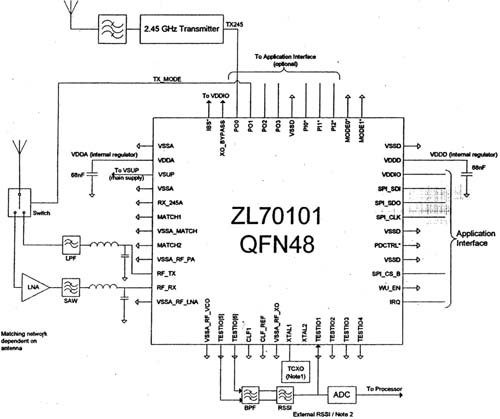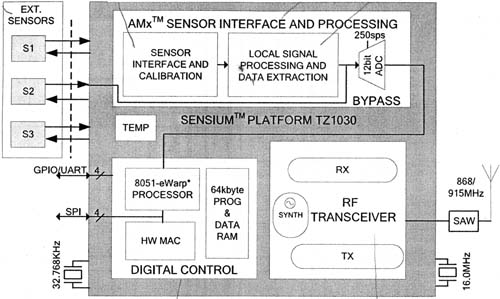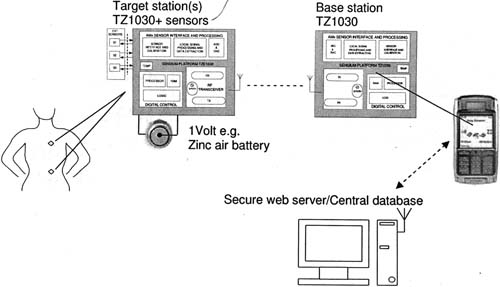Medical information communication technology (ICT) will make full use of and involve many existing high-tech technologies, such as sensor networks, network robots, RFID, and ultra-wideband (UWB), software-defined radio (SRD) and multiple input multiple output (MIMO) technologies Advanced mobile communication system; further research and development of ultra-low power amplifiers, software structure RF and on-chip antennas; in addition, packaging technology is also crucial for durable implant / intrusive devices.
In the medical and health care fields, human implant / invasive or strap-on ultra-low power consumption and miniaturization of wireless transceiver chips and sensors are used in large numbers, which will definitely promote the rapid development of the human body domain wireless network (BAN) and provide a necessary Platform, real-time transmission of human physiological parameters, to achieve remote diagnosis and treatment. For example, the Japanese government is implementing a "u-Japan" plan aimed at establishing a unique ad-hoc network for safe and reliable medical services.
The following mainly introduces the design of implanted / invasive wireless transceivers and digital electronic rash diagnosis and treatment stickers, and introduces the development of the human body network.
In-plant / intrusive device wireless communication
Zarlink Semiconductor is committed to developing implant / intrusive semiconductor chips and in-body communications. Its ultra-low power transceiver ZL70101 is used to link implant / invasive medical devices and monitoring equipment to telemetry systems. A new generation of 70102 with 0.18? M RFCMOS technology and a new wireless structure and modulation technology is also coming soon. According to the company's report, ZL70101 has been used in diagnostic pill-type cameras to capture images and transmit them to the recorder at a data rate of 2.7 Mbps at 4 frames per second. It consumes 5.2mW power during launch, and the design working time exceeds 8 hours.
ZL70101 (Figure 1) is an ultra-low-power wireless transceiver that provides high-performance half-duplex RF communication links for medical implant / invasive applications. Highly integrated devices include 10 MICS channels and 2 ISM channel 400MHz transceivers and a media access controller (MAC) that provides device control and RF message compilation, and a standard SPI interface to provide convenient connections. An optional 2.45GHz ISM band receiver provides additional wake-up functions. It uses Reed-solomen coding scheme, combined with CRC error detection to achieve a very reliable link. For data blocks, the maximum bit error rate (BER) is less than 1.5 × 10-10.

Figure 1 ZL70101 block diagram
The ZL70101 transceiver can be used for both planting / intrusive devices and base stations. In view of the two systems have different requirements for power consumption, the transceiver defines two basic start-up working methods:
Implant / Invasive Medical Device (IMD) mode: In this mode, the transceiver is usually in a sleep state, that is, in a very low current state. When in use, the IMD can be awakened through the 2.45GHz link, or directly awakened through the WU-EN pin through the IMD processing sequence.
Base station mode: In this mode, some external components can be added to obtain the best performance, as shown in Figure 2.

Figure 2 ZL70101 external component diagram
For the convenience of users, the company also launched the ZLE Application Development Kit (ADK). The plant / intrusive application middleware (AIM100) board and base station middleware BSM100) board are configured. The former includes the ZL70101 transceiver, a discrete circuit that uses normal data transmission and wake-up operations, an application microcontroller connected through an industry-standard SPI bus, and an SMA connector that interfaces to the PCB base loop antenna; the latter is based on the former, Added a received signal strength indicator that wakes up the transmit subsystem and performs clear channel access (CCA). In addition, a dual-band antenna for better performance is also provided. The kit is also equipped with an application development platform (ADP100) board, so that the computer can be connected to the AIM100 board or BSM100 board through the USB2.0 interface.
Digital electronic clinic stickers
When Zarlink of Canada is committed to in-vivo communication on the human body network, Toumaz Technology of the United Kingdom has taken another path to provide a solution for in-vitro communication, called Sensium digital electronic medical patch. As the name implies, electronic stickers can be attached to the epidermis of the human body just like wound stickers. The difference is that it is a highly integrated, ultra-low power sensor interface and transceiver platform (Figure 3), built-in reconfigurable sensor interface, Digital building block with 8051 processor, RF transceiver and on-chip temperature sensor. One or more Sensium-enabled digital electronic stickers continuously monitor important physiological parameters of the human body and report them to the Sensium base station inserted in the PDA or smartphone.

Figure 3 Digital electronic diagnosis and treatment stickers
In such applications, the system structure (Figure 4) can be divided into three units: sensor node target station, base station, and Internet service / central database. The target station supports a variety of sensors with data rates up to 50kbps and can work for one year with a 30mAhr battery. The extremely low level signal produced by the sensor can be pre-processed with on-chip programs and data memory. The base station can link up to 8 target stations, each monitoring a human's physiological parameters, such as temperature, heart rate, breathing, blood pressure, etc. The data is further filtered and processed, and then transmitted to the central database via wireless or Internet to provide a basis for health care or medical treatment.

Figure 4 TZ1030 block diagram
The core of the device is a highly integrated chip TZ1030 made with 130nm RFCMOS technology and patented advanced mixed-signal (AMX) technology (Figure 5). The working voltage of the device is 1-1.5V (zinc-air battery compatible); it has a variety of sensor interfaces: internal and external temperature sensor interfaces, single-lead ECG interface, 3-axis acceleration interface, current-type interface, current-type sensor interface; available Amplification, filtering, data conversion, data compression, modulation pre-processing functions; the transceiver's transmit power is -10dBm, the receiving sensitivity is -97dBm (0.1% bit error rate), using two-way FSK modulation, bandwidth 200KHz; carrier frequency: European ISM862-870KHz, the cause is ISM902-928MHz; the transceiver consumes 3mA current in continuous Tx / Rx mode, and the transmission distance is up to 3 meters.

Figure 5 Wireless human body monitoring system structure
Body Area Network (BAN)
With the rapid development of ultra-low power transceivers and medical sensors, it is very urgent to build a high-speed, short-range BAN. In fact, in order to achieve this goal, IEEE802 established a working group 6 (TG6) that formulated IEEE802.15 in December 2007. The working group will define a short-range, wireless communication standard within the human body. The basic points of an alternative are:
MICS frequency band: 402-405MHz (FCC47CFR95.601-95.673 sub-item E);
10 300KHz channels;
Adaptive frequency calibration;
25? W EIRP;
Medical radio FCC recommended frequency bands: 401-402MHz and 405-406MHz;
Wireless medical telemetry service (WMTS) frequency band: 608 / 614MHz (TV37 channel), 1395-1400MHz, 1427-1432MHz;
Industrial, Scientific and Medical (ISM) frequency bands: 868 / 915MHz, 2.4GHz, 5.8GHz.
UWB band;
RFID link: 135KHz, 6.78MHz, 13.56MHz (ERC Rec. 70-03);
Inductive link frequency band: 9-315KHz;
Capacitive carrier-free baseband transmission.
Researchers are also developing new physical layer (PHY) protocols for BAN. One is the ultra-low power UWB signal design technology, which is a non-coherently detected switching signal that uses a truncated triangular wave modulation sine function as a pulse waveform for PHY. The working distance of BAN ranges from 2-5 meters, and the power consumption at 1 meter distance is about 1mW / Mbps. 2-5 meters IEEE802.15.6 aims at the following three application markets: medical care, assistance facilities for the disabled, human interaction and entertainment facilities.
A large number of health and medical devices that can be brought, implanted / invaded have emerged, such as common finger-tip blood oxygen sensors, watch-type blood glucose sensors, watch-type sleep organic measuring instruments, implantable identification components, etc. The new generation of ultra-low power transceivers will raise the level of technology to a new level. If these devices can only work alone, the communication resources cannot be fully utilized, so the development of BAN is imperative. Of course, BAN is a unique local area network. Human tissue absorbs radio waves. Therefore, the BAN physical layer requires innovative technologies, while also considering human safety factors. In addition, the detection method technology is also more diverse than other local area networks. complex. These problems need to be resolved.
Power 90W ,output voltage 15-24V, output current Max 6A, 10 dc tips.
We can meet your specific requirement of the products, like label design. The plug type is US/UK/AU/EU. The material of this product is PC+ABS. All condition of our product is 100% brand new. OEM and ODM are available in our company, and you deserve the best service. You can send more details of this product, so that we can offer best service to you!
90W Desktop Adapter,90W Desktop Power Supply,90W Desktop Power Cord , 90W Desktop Power Adapter
Shenzhen Waweis Technology Co., Ltd. , https://www.waweis.com
